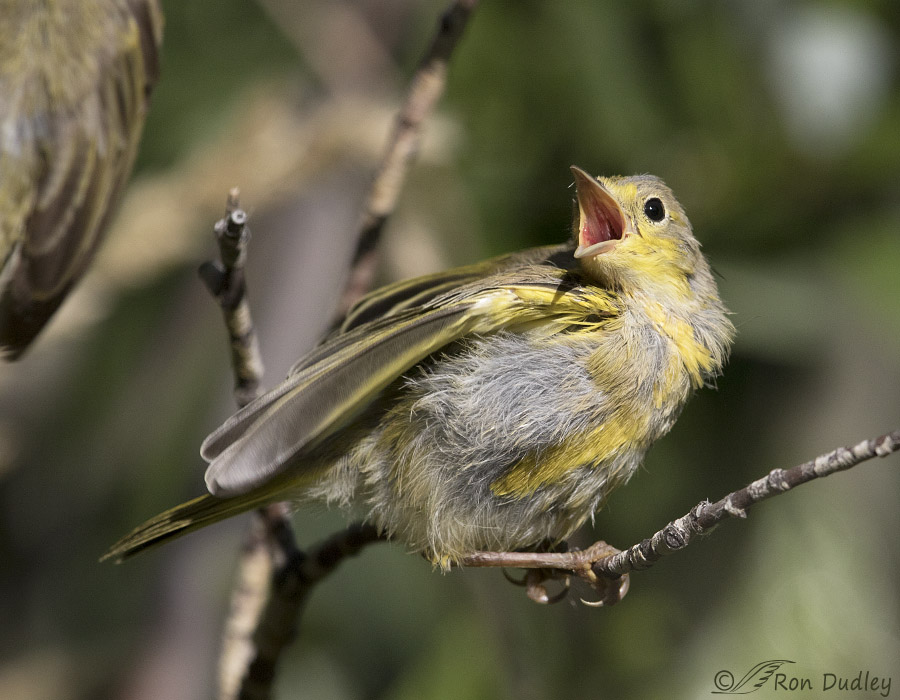I can think of no better descriptor for this recently fledged Yellow Warbler than “vulnerable”.
 1/3200, f/8, ISO 800, Canon 7D Mark II, Canon EF 500mm f/4L IS II USM + EF 1.4 III Extender, not baited, set up or called in
1/3200, f/8, ISO 800, Canon 7D Mark II, Canon EF 500mm f/4L IS II USM + EF 1.4 III Extender, not baited, set up or called in
I photographed this youngster two weeks ago in the Wasatch Mountains as “his” parents brought in food every few minutes. The poor little guy was awkward, disheveled and even unattractive as he was growing into his new plumage and he appeared to be interested in nothing more than food, food and more food.
They’re so very defenseless at this age – they’ve left the relative safety of the nest and they’re hopping around awkwardly from branch to branch as they try to anticipate from which direction a parent will be coming with their next meal. All that activity from such a young bird still learning to fly could very easily attract predators after an easy meal so thankfully their instincts instruct them to stay mostly hidden within the bushes (and believe me that made photography very difficult).
In this photo the shape we see at upper left is actually the female parent coming in with another snack. For me this isn’t a particularly attractive image but what appeals to me is the begging behavior of the chick and its obvious vulnerability.
I think it documents the precarious nature of the situation pretty well.
Ron


To further boggle: these guys leave the nest at about 10 days old. The literature says 9 to 12 days from hatch to fledging. So this little guy was an egg 2 weeks ago. No wonder he’s constantly hungry!
Fabulous shot and description, Ron! Life is as precarious a balancing act as this youngster balancing on the branch.
I thought of you and Laura this morning — did you get my “vibes?” We were doing another big spay/neuter day at the shelter and I had an hour to play with this morning before I had to move animals to recovery. I sat in the gazebo with an adorable black and white terrier mix and watched two Red Tails lazily circle up above. The green trees, the bright blue sky, the gentle breeze, a couple of raptors, and a furry buddy — perfection! As Dick would say, VBG!
We were doing another big spay/neuter day at the shelter and I had an hour to play with this morning before I had to move animals to recovery. I sat in the gazebo with an adorable black and white terrier mix and watched two Red Tails lazily circle up above. The green trees, the bright blue sky, the gentle breeze, a couple of raptors, and a furry buddy — perfection! As Dick would say, VBG! 
Wish I’d been there to share it with you, Marty.
Awww Marty, sounds like a perfect day to me! Whenever I see redtails soaring, I think of Kate Wolf’s lyric, “The redtail hawk writes songs across the sky.” Add in holding a puppy/dog and I’m as happy as I can be!
Vulnerable, fragile and precious.
You captured the vulnerability of this youngster very well. I didn’t even notice the incoming adult in the photo until I looked again after you mentioned it.
That adult would be easy to miss, Susan.
Like raptors survival rates in the first year of life is low for passerines too. I had to stop reading the research reports, it was quite bleak.
May this youngster live a long, reproductive, healthy life!
I hope it does, April!
That baby sure looks scruffy! They are so tiny and defenseless it’s amazing any of them survive…I wish that little guy a lot of luck!!!
Yup, at that age he needed it, Patty!
Patty, my daughter I call them Tweens, like kids they are awkward and in between childhood and adulthood.
Perfect! And when they’re that small, maybe teeny, tiny, tweenies….
Vulnerable is right. In addition to the feed me, feed me, feed me behavior, they often need a nap just like other kids. And when their nap attacks happen, they’re even more vulnerable. When I lived in Dallas and had lots of nesting birds around the heavily wooded property, it wasn’t unusual to find a juvenile napping, perched on a low branch and totally oblivious of what was going on around it. That phase didn’t last long, maybe a week, but I was able to walk right up to a napping kiddo! It was always accidental and I froze in my tracks, but I also felt like I needed to stand guard to protect the little ones until they were finished napping!
Laura, this one didn’t nap while I was there. I think he was afraid he’d miss a feeding opportunity!
Vulnerable. Perfect description.
Thanks, Arwen.
They certainly are vulnerable! He is a “mess” and, hopefully, things have improved! Tho he shows up well here I KNOW how well they blend in with their surroundings in the brush. Glad you captured it…………
Glad you captured it…………
He is a mess, Judy – partly because he hadn’t yet groomed himself after a recent bath but he always looked pretty rough on that day.
Great behavioral catch! Fledglings that young are difficult to see. I’ve been in the field for 3 years now, documenting breeding behavior in Wisconsin birds, and I have not had the luck to observe what you document here. I see older fledglings often.
I was lucky with this youngster, Pam. This was the first time I’ve photographed a warbler of any species at this age.